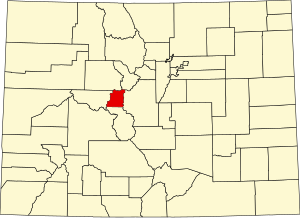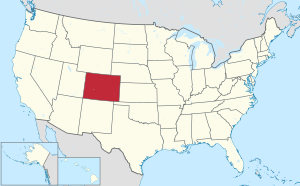Lake County, Colorado
Lake County | |
|---|---|
 Courthouse in Leadville, Colorado. | |
 Location within the U.S. state of Colorado | |
 Colorado's location within the U.S. | |
| Coordinates: 39°11′N 106°22′W / 39.19°N 106.36°W | |
| Country | |
| State | |
| Founded | November 1, 1861 |
| Named for | Twin Lakes in the area |
| Seat | Leadville |
| Largest city | Leadville |
| Area | |
• Total | 384 sq mi (990 km2) |
| • Land | 377 sq mi (980 km2) |
| • Water | 7.0 sq mi (18 km2) 1.8% |
| Population (2020) | |
• Total | 7,436 |
| • Density | 20/sq mi (8/km2) |
| Time zone | UTC−7 (Mountain) |
| • Summer (DST) | UTC−6 (MDT) |
| Congressional district | 7th |
| Website | www |

Lake County is a county located in the U.S. state of Colorado. As of the 2020 census, the population was 7,436.[1] The county seat and the only municipality in the county is Leadville.[2] The highest natural point in Colorado and the entire Rocky Mountains is the summit of Mount Elbert in Lake County at 14,440 feet (4,400 meters) elevation.
History
[edit]Lake County was one of the original 17 counties created by the Colorado legislature on November 1, 1861. As originally defined, Lake County included a large portion of western Colorado to the south and west of its present boundaries. The county was named for Twin Lakes.
Placer gold was found at Colorado Gulch in 1863 as part of the Colorado Gold Rush.[3]: 30
Lake County slowly lost territory over the succeeding decades, losing land in its southeast to Saguache County in 1866 and Hinsdale County in 1874; in its southwest to La Plata County in 1874 and San Juan County in 1876, and in its west to Ouray and Gunnison counties in 1877.
With its many reductions in size, Lake County's designated county seat also changed multiple times within just a few years, residing successively in Oro City (from 1861), Lourette (from 1863), Dayton (from 1866), and Granite (from 1868).
By 1878, Lake County had been reduced to an area including only present-day Lake and Chaffee counties. On February 8, 1879, the Colorado legislature renamed Lake County as Carbonate County, although this designation name only lasted for two days, until Chaffee County was split off from Carbonate's southern section on February 10 and the remaining northern portion was redesignated Lake County with its current county seat of Leadville.
Geography
[edit]According to the U.S. Census Bureau, the county has a total area of 384 square miles (990 km2), of which 377 square miles (980 km2) is land and 7.0 square miles (18 km2) (1.8%) is water.[4] It is the fourth-smallest county in Colorado by area.
As the courthouse with the highest elevation in the United States, the Lake County courthouse in Leadville is the "highest court" in the land.
Adjacent counties
[edit]- Eagle County – north
- Summit County – northeast
- Park County – east
- Chaffee County – south
- Pitkin County – west
Major highways
[edit]In popular culture
[edit]The 2013 horror video game Outlast is set in a fictional asylum in Lake County.
Demographics
[edit]| Census | Pop. | Note | %± |
|---|---|---|---|
| 1870 | 522 | — | |
| 1880 | 23,569 | 4,415.1% | |
| 1890 | 14,603 | −38.0% | |
| 1900 | 18,054 | 23.6% | |
| 1910 | 10,600 | −41.3% | |
| 1920 | 6,630 | −37.5% | |
| 1930 | 4,899 | −26.1% | |
| 1940 | 6,833 | 39.5% | |
| 1950 | 8,600 | 25.9% | |
| 1960 | 7,101 | −17.4% | |
| 1970 | 8,318 | 17.1% | |
| 1980 | 7,491 | −9.9% | |
| 1990 | 6,007 | −19.8% | |
| 2000 | 7,102 | 18.2% | |
| 2010 | 7,310 | 2.9% | |
| 2020 | 7,436 | 1.7% | |
| 2023 (est.) | 7,365 | [5] | −1.0% |
| U.S. Decennial Census[6] 1790–1960[7] 1900–1990[8] 1990–2000[9] 2010–2020[1] | |||
As of the census[10] of 2000, there were 7,812 people, 2,977 households, and 1,914 families living in the county. The population density was 21 people per square mile (8.1 people/km2). There were 3,913 housing units at an average density of 10 units per square mile (3.9 units/km2). The racial makeup of the county was 77.60% White, 0.18% Black or African American, 1.25% Native American, 0.31% Asian, 0.05% Pacific Islander, 17.99% from other races, and 2.62% from two or more races. 36.14% of the population were Hispanic or Latino of any race.
There were 2,977 households, out of which 33.90% had children under the age of 18 living with them, 50.70% were married couples living together, 8.40% had a female householder with no husband present, and 35.70% were non-families. 26.30% of all households were made up of individuals, and 5.60% had someone living alone who was 65 years of age or older. The average household size was 2.59 and the average family size was 3.15.
In the county, the population was spread out, with 26.90% under the age of 18, 12.80% from 18 to 24, 33.10% from 25 to 44, 20.60% from 45 to 64, and 6.60% who were 65 years of age or older. The median age was 30 years. For every 100 females there were 115.80 males. For every 100 females age 18 and over, there were 116.70 males.
The median income for a household in the county was $37,691, and the median income for a family was $41,652. Males had a median income of $30,977 versus $24,415 for females. The per capita income for the county was $18,524. About 9.50% of families and 12.90% of the population were below the poverty line, including 15.60% of those under age 18 and 6.30% of those age 65 or over.
Politics
[edit]| Year | Republican | Democratic | Third party(ies) | |||
|---|---|---|---|---|---|---|
| No. | % | No. | % | No. | % | |
| 2024 | 1,557 | 39.79% | 2,199 | 56.20% | 157 | 4.01% |
| 2020 | 1,497 | 37.79% | 2,303 | 58.14% | 161 | 4.06% |
| 2016 | 1,270 | 39.70% | 1,616 | 50.52% | 313 | 9.78% |
| 2012 | 1,098 | 36.12% | 1,839 | 60.49% | 103 | 3.39% |
| 2008 | 1,078 | 35.91% | 1,859 | 61.93% | 65 | 2.17% |
| 2004 | 1,261 | 42.76% | 1,623 | 55.04% | 65 | 2.20% |
| 2000 | 1,056 | 40.18% | 1,296 | 49.32% | 276 | 10.50% |
| 1996 | 728 | 29.71% | 1,338 | 54.61% | 384 | 15.67% |
| 1992 | 605 | 20.70% | 1,426 | 48.79% | 892 | 30.52% |
| 1988 | 969 | 38.10% | 1,516 | 59.61% | 58 | 2.28% |
| 1984 | 1,364 | 49.65% | 1,324 | 48.20% | 59 | 2.15% |
| 1980 | 1,375 | 45.45% | 1,213 | 40.10% | 437 | 14.45% |
| 1976 | 1,575 | 48.03% | 1,549 | 47.24% | 155 | 4.73% |
| 1972 | 1,556 | 53.67% | 1,263 | 43.57% | 80 | 2.76% |
| 1968 | 1,025 | 35.50% | 1,550 | 53.69% | 312 | 10.81% |
| 1964 | 681 | 22.32% | 2,362 | 77.42% | 8 | 0.26% |
| 1960 | 954 | 34.03% | 1,842 | 65.72% | 7 | 0.25% |
| 1956 | 1,433 | 51.31% | 1,355 | 48.51% | 5 | 0.18% |
| 1952 | 1,303 | 44.98% | 1,585 | 54.71% | 9 | 0.31% |
| 1948 | 838 | 33.49% | 1,581 | 63.19% | 83 | 3.32% |
| 1944 | 1,236 | 42.08% | 1,687 | 57.44% | 14 | 0.48% |
| 1940 | 1,403 | 40.30% | 2,063 | 59.26% | 15 | 0.43% |
| 1936 | 650 | 23.03% | 2,146 | 76.02% | 27 | 0.96% |
| 1932 | 801 | 34.89% | 1,436 | 62.54% | 59 | 2.57% |
| 1928 | 990 | 40.10% | 1,449 | 58.69% | 30 | 1.22% |
| 1924 | 1,005 | 43.00% | 613 | 26.23% | 719 | 30.77% |
| 1920 | 1,287 | 53.16% | 992 | 40.97% | 142 | 5.87% |
| 1916 | 993 | 25.46% | 2,672 | 68.51% | 235 | 6.03% |
| 1912 | 966 | 22.92% | 1,933 | 45.87% | 1,315 | 31.21% |
| 1908 | 1,918 | 40.08% | 2,652 | 55.41% | 216 | 4.51% |
| 1904 | 3,026 | 50.07% | 2,936 | 48.59% | 81 | 1.34% |
| 1900 | 2,385 | 32.60% | 4,755 | 65.00% | 175 | 2.39% |
| 1896 | 255 | 3.76% | 6,518 | 96.04% | 14 | 0.21% |
| 1892 | 1,003 | 30.68% | 0 | 0.00% | 2,266 | 69.32% |
| 1888 | 2,901 | 54.01% | 2,413 | 44.93% | 57 | 1.06% |
| 1884 | 3,416 | 55.52% | 2,661 | 43.25% | 76 | 1.24% |
| 1880 | 3,801 | 46.70% | 4,197 | 51.56% | 142 | 1.74% |
Lake County has leaned towards the Democratic Party for most of its history, voting for that party's presidential nominee in every election since 1988.
Communities
[edit]City
[edit]Census-designated places
[edit]Unincorporated community
[edit]Ghost Town
[edit]Historic sites
[edit]
Recreation
[edit]State protected area
[edit]National protected areas
[edit]- San Isabel National Forest (part)
- Buffalo Peaks Wilderness (part)
- Collegiate Peaks Wilderness (part)
- Holy Cross Wilderness (part)
- Mount Massive Wilderness (part)
Trails
[edit]- American Discovery Trail
- Colorado Trail
- Continental Divide National Scenic Trail
- Mineral Belt National Recreation Trail
Scenic byway
[edit]See also
[edit]- Bibliography of Colorado
- Geography of Colorado
- History of Colorado
- Index of Colorado-related articles
- List of Colorado-related lists
- Outline of Colorado
References
[edit]- ^ a b "State & County QuickFacts". United States Census Bureau. Retrieved September 5, 2021.
- ^ "Find a County". National Association of Counties. Retrieved June 7, 2011.
- ^ Voynick, S.M., 1992, Colorado Gold, Missoula: Mountain Press Publishing Company, ISBN 0878424555
- ^ "US Gazetteer files: 2010, 2000, and 1990". United States Census Bureau. February 12, 2011. Retrieved April 23, 2011.
- ^ "Annual Estimates of the Resident Population for Counties: April 1, 2020 to July 1, 2023". United States Census Bureau. Retrieved March 31, 2024.
- ^ "U.S. Decennial Census". United States Census Bureau. Retrieved June 8, 2014.
- ^ "Historical Census Browser". University of Virginia Library. Retrieved June 8, 2014.
- ^ "Population of Counties by Decennial Census: 1900 to 1990". United States Census Bureau. Retrieved June 8, 2014.
- ^ "Census 2000 PHC-T-4. Ranking Tables for Counties: 1990 and 2000" (PDF). United States Census Bureau. Archived (PDF) from the original on March 27, 2010. Retrieved June 8, 2014.
- ^ "U.S. Census website". United States Census Bureau. Retrieved May 14, 2011.
- ^ Leip, David. "Dave Leip's Atlas of U.S. Presidential Elections". uselectionatlas.org. Retrieved May 26, 2017.


